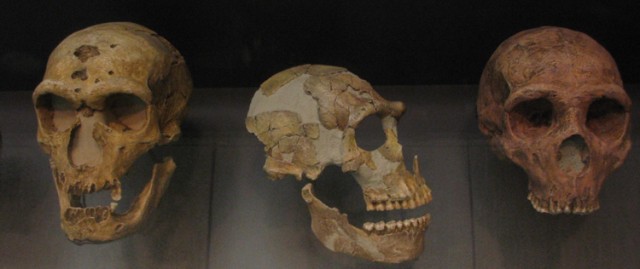
The completion of a Neanderthal genome showed that there was a very clear signal of Neanderthal DNA in all non-African populations of modern humans, demonstrating that the two populations had interbred during the latter's migration into Eurasia. But a statistical signal doesn't really tell you what's there. Do all humans carry the same few pieces of Neanderthal DNA, suggesting it has been contributing to our fitness? Or have bits of Neanderthal been scattered through the human genome, kept around by little more than random drift?
Two papers, one in Nature and the second in Science, attempt to answer these questions. Conveniently, they come up with the same answer. Yes, lots of Neanderthal DNA is scattered around at random—enough so that if it were all brought together in one individual, that person would be 20 percent Neanderthal. But there are also lots of bits that aren't located randomly. Some of them are useful, many others less so.
Given that we now have a few Neanderthal genomes, it might seem easy to spot pieces of DNA that originated there. But the Neanderthal genome is so similar to that of modern humans that it can be difficult to tell whether something originated the the Neanderthals or whether it's just a bit of normal variation. The task is made harder by the fact that recombination has scrambled the Neanderthal and human chromosomes so that the typical piece of Neanderthal DNA should now be less than a hundred thousand bases long; the chromosomes are millions of bases.
Both papers take a very similar approach to finding bits of Neanderthal. They start with hundreds of genomes and look for regions where there are stretches of variation that are present in non-Africans but absent from African populations. Those stretches should be roughly in the size range mentioned above based on the fact that humans and Neanderthals interbred at least 40,000 years ago. And if a sequence clears those hurdles, it should be checked against the Neanderthal genome.
The two papers come up with fairly similar results. The average individual has about 23 Megabases (23 million base pairs) from the Neanderthal genome. East Asians have a bit more, consistent with further interbreeding between Neanderthals and the humans who migrated to that area.
But it's not the same 23 Megabases. Collectively, the hundreds of individuals examined have about 600 Megabases of distinct Neanderthal DNA, which is roughly 20 percent of the entire genome. So each individual has its own patchwork of Neanderthal DNA scattered throughout the genome.
But is it scattered randomly? To look at that, the researchers checked for whether different segments of DNA showed up more or less often than would be predicted by chance. And the results suggest that our Neanderthal inheritance has been both good and bad. On the good side, Neanderthal DNA is more common in genes that contribute to our hair and skin, suggesting that they might have helped modern humans adapt to the environmental conditions in Eurasia.
However, there are also a number of places in the genome where Neanderthal DNA is exceedingly rare. The authors of the Nature paper show that these locations contain genes that are highly expressed in the testes, many of them located on the X chromosome. They conclude that these areas probably contain genes that influenced the fertility of the male hybrids and therefore were the subject of very strong evolutionary pressures. This also may explain why successful interbreeding seems to have been relatively rare.
Also on the negative side of things, the researchers show that a number of the genes where Neanderthal DNA is present has been associated with human health problems, including "Alleles of Neanderthal origin that affect lupus, biliary cirrhosis, Crohn’s disease, optic-disk size, smoking behavior, [immune function,] and type 2 diabetes."
With these new analyses, we now have a much clearer picture of the genetic legacy left to us by our now extinct relatives—and, as with most things in life, it's a bit complicated. But the complications may not end here. The group behind the Science paper has an earlier one that used the same statistical analysis to look at African DNA, and they find suggestions that the ancestors of West Africans had interbred with a completely different archaic human population. As of yet, we have no fossil evidence of such a group existing.
Nature , 2014. DOI: 10.1038/nature12961, Science, 2014. DOI: 10.1126/science.1245938 (About DOIs).
reader comments
96